
Mo Putera
Bio
Participation4
CE Research Training Program graduate and research contractor at ARMoR under the Global Impact Placements program, working on cost-benefit analyses to help combat AMR. Currently exploring roles involving research distillation and quantitative analysis to improve decision-making e.g. applied prioritization research, previously supported by a FTX Future Fund regrant and later Open Philanthropy's affected grantees program. Previously spent 6 years doing data analytics, business intelligence and knowledge + project management in various industries (airlines, e-commerce) and departments (commercial, marketing), after majoring in physics at UCLA. Also collaborating on a local charity evaluation initiative with the moonshot aim of reorienting Malaysia's giving landscape towards effectiveness.
I first learned about effective altruism circa 2014 via A Modest Proposal, a polemic on using dead children as units of currency to force readers to grapple with the opportunity costs of subpar resource allocation under triage. I have never stopped thinking about it since, although my relationship to it has changed quite a bit; I related to Tyler's personal story (which unsurprisingly also references A Modest Proposal as a life-changing polemic):
I thought my own story might be more relatable for friends with a history of devotion – unusual people who’ve found themselves dedicating their lives to a particular moral vision, whether it was (or is) Buddhism, Christianity, social justice, or climate activism. When these visions gobble up all other meaning in the life of their devotees, well, that sucks. I go through my own history of devotion to effective altruism. It’s the story of [wanting to help] turning into [needing to help] turning into [living to help] turning into [wanting to die] turning into [wanting to help again, because helping is part of a rich life].
Posts 3
Comments113
Topic contributions3
Appreciate the pointer to that post! That's basically the sort of thing I'm looking for (more reading material for 'gears'). And thanks again for writing the main post.
Great post, thank you for writing it. I particularly appreciate the sketch of your causal model summarizing the evidence for the relationships between growth, liberal democracy, human capital, peace, and x-risk; I think you deconfused me quite a bit w.r.t "the world getting better" with that.
But even if GDP percentage growth slows, wellbeing growth can still speed up, for two reasons:
- The dollar GDP/capita growth rate goes up. Even if we adjust for inflation, Americans had ~$600 more every year in the 60s, but now have ~$900 more per year in the 2010s.[65]
At first blush this seemed wrong, since I tend to assume log utility to simplify modeling. Your footnote linking to Basil Halperin's essay does note that this assumption is in fact an assumption, and that if utility is in fact "less curved" than log we can still have wellbeing growth speedup with GDP % growth slowdown (this was probably obvious to you but isn't clarified in the text):
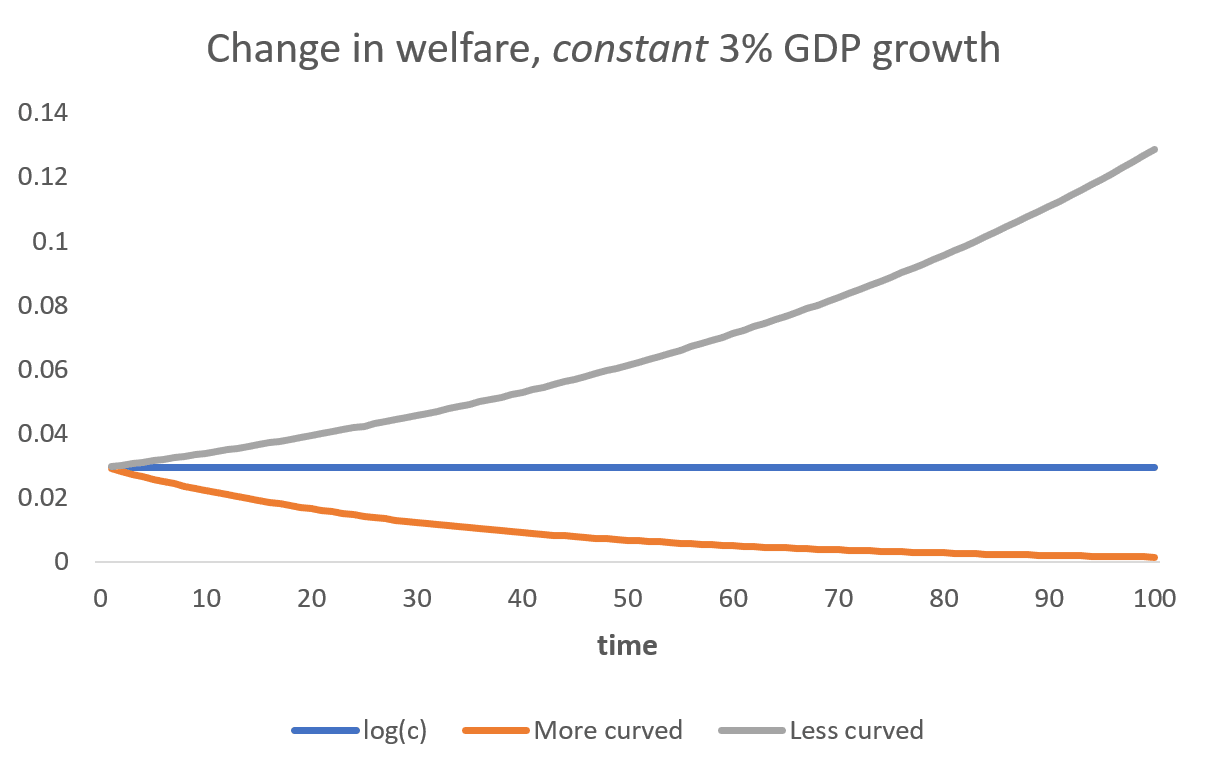
But Halperin's essay doesn't actually explore whether this "less curved than log" assumption is true. Do you happen to know of empirical evidence for it?
The only reference I've come across provides evidence against it – it's this section in Sam Nolan's Quantifying Uncertainty in GiveWell's GiveDirectly Cost-Effectiveness Analysis. Quote:
Isoelastic vs Logarithmic increases in consumption
GiveWell measures GiveDirectly's cost-effectiveness by doublings of consumption per year. For instance, Increasing an individual's consumption from $285.92 to $571.84 for a year would be considered 1 unit of utility.
However, there is a bit of ambiguity here. What happens when you double someone's consumption twice? For instance, $285.92 to $1,143.68 a year? So, if increasing consumption by 100% has a utility of 1, how much utility does this have? A natural answer might be that doubling twice creates two units of utility. This answer is what the GiveWell CEA currently assumes. This assumption is implicit by representing utility as logarithmic increases in consumption.
However, how much people prefer the first double of consumption over the second is an empirical question. And empirically, people get more utility from the first doubling of consumption than the second. Doubling twice creates 1.66 units rather than 2. An isoelastic utility function can represent this difference in preferences.
Isoelastic utility functions allow you to specify how much one would prefer the first double to the second with the parameter. When , the recipient values the first double the same as the second and is what the current CEA assumes. When , recipients prefer the first doubling in consumption as worth more than the second. Empirically, . GiveWell recognises this and uses in their calculation of the discount rate:
Increases in consumption over time meaning marginal increases in consumption in the future are less valuable. We chose a rate of 1.7% based on an expectation that economic consumption would grow at 3% each year, and the function through which consumption translates to welfare is isoelastic with eta=1.59. (Note that this discount rate should be applied to increases in ln(consumption), rather than increases in absolute consumption; see calculations here)
I've created a desmos calculator to explore this concept. From the calculator, you can change the value of and see how isoelastic utility compares to logarithmic utility.
GiveDirectly transfers don't usually double someone's consumption for a year but increase it by a lower factor. So an isoelastic utility would find that recipients would gain more utility than logarithmic utility implies.
Changing from 1 to 1.59 increases GiveDirectly's cost-effectiveness by 11%. Reducing the cost of doubling someone's consumption for a year from $466.34 to $415.87.
To be clear, I don't know anything else about this topic; I was just surprised/skeptical to see the wellbeing growth speedup point.
Edited to add: I was trivially wrong, sorry, I misread Sam's post. Quoting the relevant section from the passage above:
When , recipients prefer the first doubling in consumption as worth more than the second. Empirically, . GiveWell recognises this and uses in their calculation of the discount rate
So this is evidence for your point, not against.
This WHO press release was a good reminder of the power of immunization – a new study forthcoming publication in The Lancet reports that (liberally quoting / paraphrasing the release)
- global immunization efforts have saved an estimated 154 million lives over the past 50 years, 146 million of them children under 5 and 101 million of them infants
- for each life saved through immunization, an average of 66 years of full health were gained – with a total of 10.2 billion full health years gained over the five decades
- measles vaccination accounted for 60% of the lives saved due to immunization, and will likely remain the top contributor in the future
- vaccination against 14 diseases has directly contributed to reducing infant deaths by 40% globally, and by more than 50% in the African Region
- the 14 diseases: diphtheria, Haemophilus influenzae type B, hepatitis B, Japanese encephalitis, measles, meningitis A, pertussis, invasive pneumococcal disease, polio, rotavirus, rubella, tetanus, tuberculosis, and yellow fever
- fewer than 5% of infants globally had access to routine immunization when the Expanded Programme on Immunization (EPI) was launched 50 years ago in 1974 by the World Health Assembly; today 84% of infants are protected with 3 doses of the vaccine against diphtheria, tetanus and pertussis (DTP) – the global marker for immunization coverage
- there's still a lot to be done – for instance, 67 million children missed out on one or more vaccines during the pandemic years
The 1,000-ton rule is Richard Parncutt's suggestion for reframing the political message of the severity of global warming in particularly vivid human rights terms; it says that someone in the next century or two is prematurely killed every time humanity burns 1,000 tons of carbon.
I came across this paper while (in the spirit of Nuno's suggestion) trying to figure out the 'moral cost of climate change' so to speak, driven by my annoyance that e.g. climate charity BOTECs reported $ per ton of CO2-eq averted in contrast to (say) the $ per death averted bottomline of GHW charities, since I don't intrinsically care to avert CO2-equivalent emissions the way I do about averting deaths. (To be clear, I understand why the BOTECs do so and would do the same for work; this is for my own moral clarity.)
Parncutt's derivation is simple: burning a trillion tons of carbon will cause ~2 °C of anthropogenic global warming, which will in turn cause 1 - 10 million premature deaths a year "for a period of several centuries", something like this:
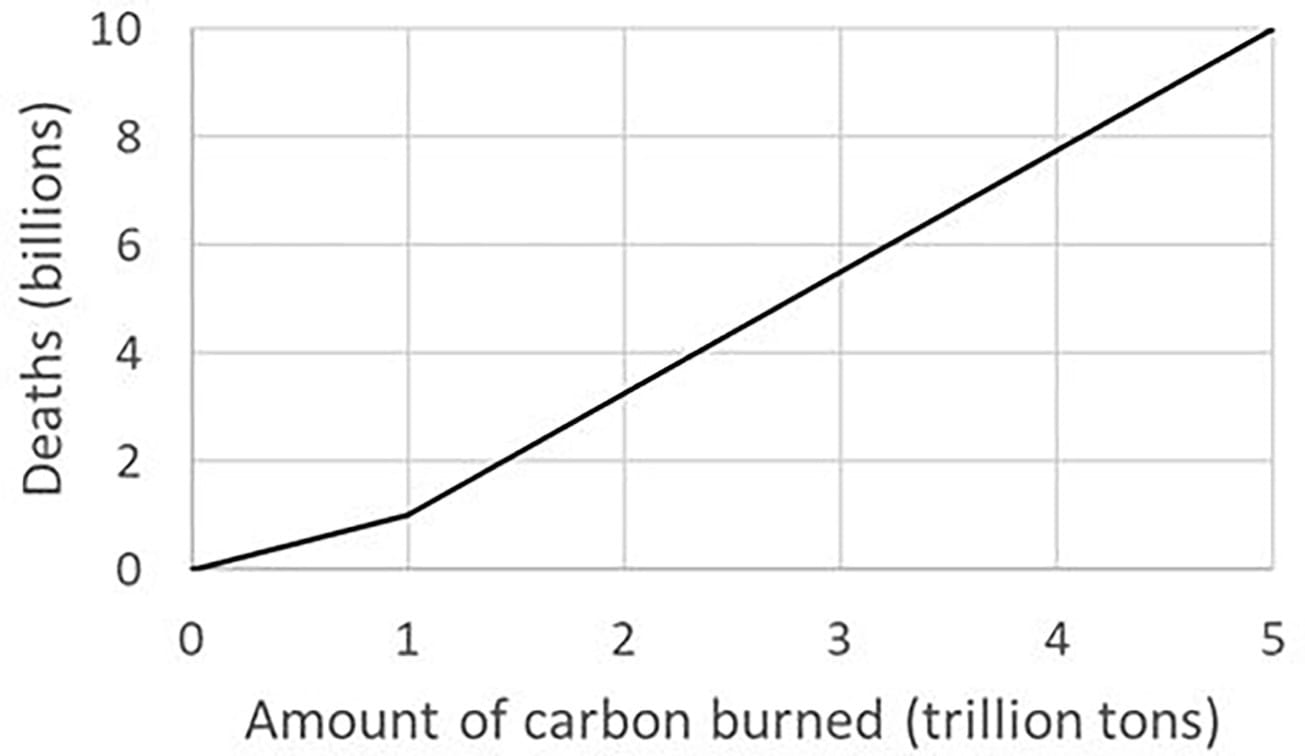
The lower line represents deaths due to poverty without AGW. As the negative effect of AGW overtakes the positive effect of development, the death rate will increase, as shown by the upper line. In a more accurate model, the upper line might be concave upward on the left (exponential increase) and concave downward on the right (approaching a peak).
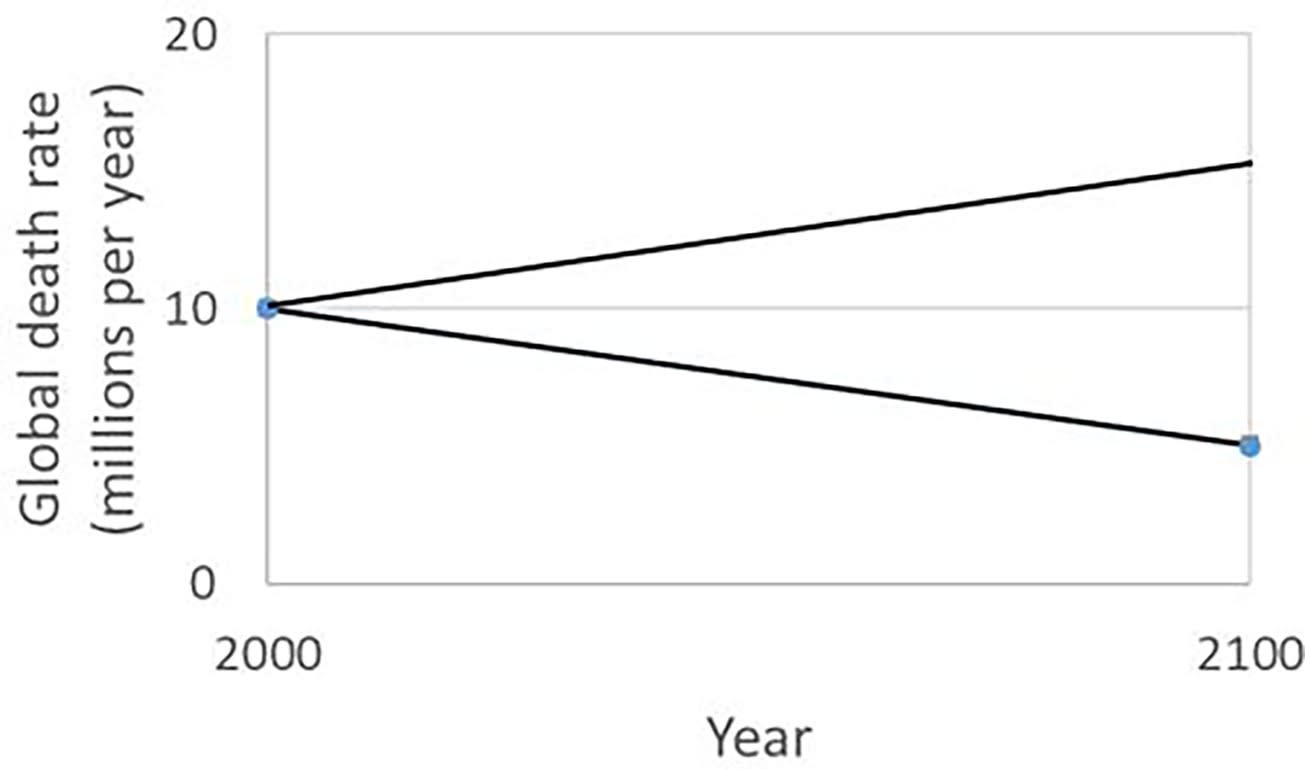
Based on the 1,000-ton rule, Pearce & Parncutt suggest the 'millilife' as "an accessible unit of measure for carbon footprints that is easy to understand and may be used to set energy policy to help accelerate carbon emissions reductions". A millilife is a measure of intrinsic value defined to be 1/1000th of a human life; the 1,000-ton rule says that burning a ton of fossil carbon destroys a millilife. This lets Pearce & Parncutt make statements like these, at an individual level (all emphasis mine):
For example in Canada, which has some of the highest yearly carbon emissions per capita in the world at around 19 tons of CO2 or 5 tons of carbon per person, roughly 5 millilives are sacrificed by an average person each year. As the average Canadian lives to be about 80, he/she sacrifices about 400 millilives (0.4 human lives) in the course of his/her lifetime, in exchange for a carbon-intensive lifestyle
and
... an average future AGW-victim in a developing country will lose half of a lifetime or 30–40 life-years, as most victims will be either very young or very old. If the average climate victim loses 35 life-years (or 13,000 life-days), a millilife corresponds to 13 days.
Stated in another way: if a person is responsible for burning a ton of fossil carbon by flying to another continent and back, they effectively steal 13 days from the life of a future poor person living in the developing world. If the traveler takes 1000 such trips, they are responsible for the death of a future person.
and for "large-scale energy decisions":
... the Adani Carmichael coalmine in Queensland, Australia, is currently under construction and producing coal since 2021. Despite massive protests over several years, it will be the biggest coalmine ever. Its reserves are up to 4 billion tons of coal, or 3 billion tons of carbon. If all of that was burned, the 1000-tonne rule says it would cause the premature deaths of 3 million future people. Given that the 1000-tonne rule is only an order-of-magnitude estimate, the number of caused deaths will lie between one million and 10 million. ... Many of those who will die are already living as children in the Global South; burning Carmichael coal will cause their future deaths with a high probability. Should energy policy allow that to occur?
Pearce & Parncutt then use the 1,000-ton rule and millilife to make various suggestions. Here's one:
Under what circumstances might a government ban or outlaw an entire corporation or industry, considered a legal entity or person—for example, the entire global coal industry? ...
Ideally, a company should not cause any human deaths at all. If it does, those deaths should be justifiable in terms of improvements to the quality of life of others. For example, a company that builds a bridge might reasonably risk a future collapse that would kill 100 people with a probability of 1%. In that case, the company accepts that on average one future person will be killed as a result of the construction of the bridge. It may be reasonable to claim that the improved quality of life for thousands or millions of people who cross the bridge justifies the human cost.
Fossil fuel industries are causing far more future deaths than that, raising the question of the point at which the law should intervene. As a first step to solving this problem, it has been proposed a rather high threshold (generous toward the corporations) is appropriate. A company does not have the right to exist if its net impact on human life (e.g., a company/industry might make products that save lives like medicine but do kill a small fraction of users) is such that it kills more people than it employs. This requirement for a company’s existence is thus:
Number of future premature deaths/year < Number of full-time employees (1)
This criterion can be applied to an entire industry. If the industry kills more people than it employs, then primary rights (life) are being sacrificed for secondary rights (jobs or profits) and the net benefit to humankind is negative. If an industry is not able to satisfy Equation (1), it should be closed down by the government.
... the coal industry kills people by polluting the air that they breathe. ... In the U.S., about 52,000 human lives are sacrificed per year to provide coal-fired electricity. ... In the U.S., coal employed 51,795 people in 2016. Since the number of people killed is greater than the number employed, the U.S. coal industry does not satisfy Equation (1) and should be closed down. This conservative conclusion does not include future deaths caused by climate change due to burning coal.
One more energy policy suggestion (there's many more in the paper):
Applying asset forfeiture laws (also referred to as asset seizure) to manslaughter caused by AGW. These laws enable the confiscation of assets by the U.S. government as a type of criminal-justice financial obligation that applies to the proceeds of crime. Essentially, if criminals profit from the results of unlawful activity, the profits (assets) are confiscated by the authorities.
This is not only a law in the U.S. but is in place throughout the world. For example, in Canada, Part XII.2 of the Criminal Code, provides a national forfeiture régime for property arising from the commission of indictable offenses. Similarly, ‘Son of Sam laws’ could also apply to carbon emissions. In the U.S., Son of Sam laws refer to laws designed to keep criminals from profiting from the notoriety of their crimes and often authorize the state to seize funds earned by the criminals to be used to compensate the criminal’s victims.
If that logic of asset forfeiture is applied to fossil fuel company investors who profit from carbon-emission-related manslaughter, taxes could be set on fossil fuel profits, dividends, and capital gains at 100% and the resultant tax revenue could be used for energy efficiency and renewable energy projects or to help shield the poor from the most severe impacts of AGW. ...
Such AGW-focused asset forfeiture laws would also apply to fossil fuel company executive compensation packages. Energy policy research has shown that it is possible to align energy executive compensation with careful calibration of incentive equations such that the harmful effects of emissions can be prevented through incentive pay. Executives who were compensated without these safeguards in place would have their incomes seized the same as other criminals benefiting materially from manslaughter.
I have no (defensible) opinion on these suggestions; curious to know what anyone thinks.
Yeah rising inequality is a good guess, thank you – the OWID chart also shows the US experiencing the same trajectory direction as India (declining average LS despite rising GDP per capita). I suppose one way to test this hypothesis is to see if China had inequality rise significantly as well in the 2011-23 period, since it had the expected LS-and-GDP-trending-up trajectory. Probably a weak test due to potential confounders...
Thank you for the pointer!
Your second link helped me refine my line of questioning / confusion. You're right that social support declined a lot, but the sum of the six key variables (GDP per capita, etc) still mostly trended upwards over time, huge covid dip aside, which is what I'd expect in the India development success story.
It's the dystopia residual that keeps dropping, from 2.275 - 1.83 = 0.445 in 2015 (i.e. Indians reported 0.445 points higher life satisfaction than you'd predict using the model) to 0.979 - 1.83 = -0.85, an absolute plummeting of life satisfaction across a sizeable fraction of the world population, that's for some reason not explained by the six key variables. Hm...
(please don't feel obliged to respond – I appreciate the link!)
Why did India's happiness ratings consistently drop so much over time even as its GDP per capita rose?
Epistemic status: confused. Haven't looked into this for more than a few minutes
My friend recently alerted me to an observation that puzzled him: this dynamic chart from Our World in Data's happiness and life satisfaction article showing how India's self-reported life satisfaction dropped an astounding -1.20 points (4.97 to 3.78) from 2011 to 2021, even as its GDP per capita rose +51% (I$4,374 to I$6,592 in 2017 prices):
(I included China for comparison to illustrate the sort of trajectory I expected to see for India.)
The sliding year scale on OWID's chart shows how this drop has been consistent and worsening over the years. This picture hasn't changed much recently: the most recent 2024 World Happiness Report reports a 4.05 rating averaged over the 3-year window 2021-23, only slightly above the 2021 rating.
A -1.20 point drop is huge. For context, it's 10x(!) larger than the effect of doubling income at +0.12 LS points (Clarke et al 2018 p199, via HLI's report), and compares to major negative life events like widowhood and extended unemployment:
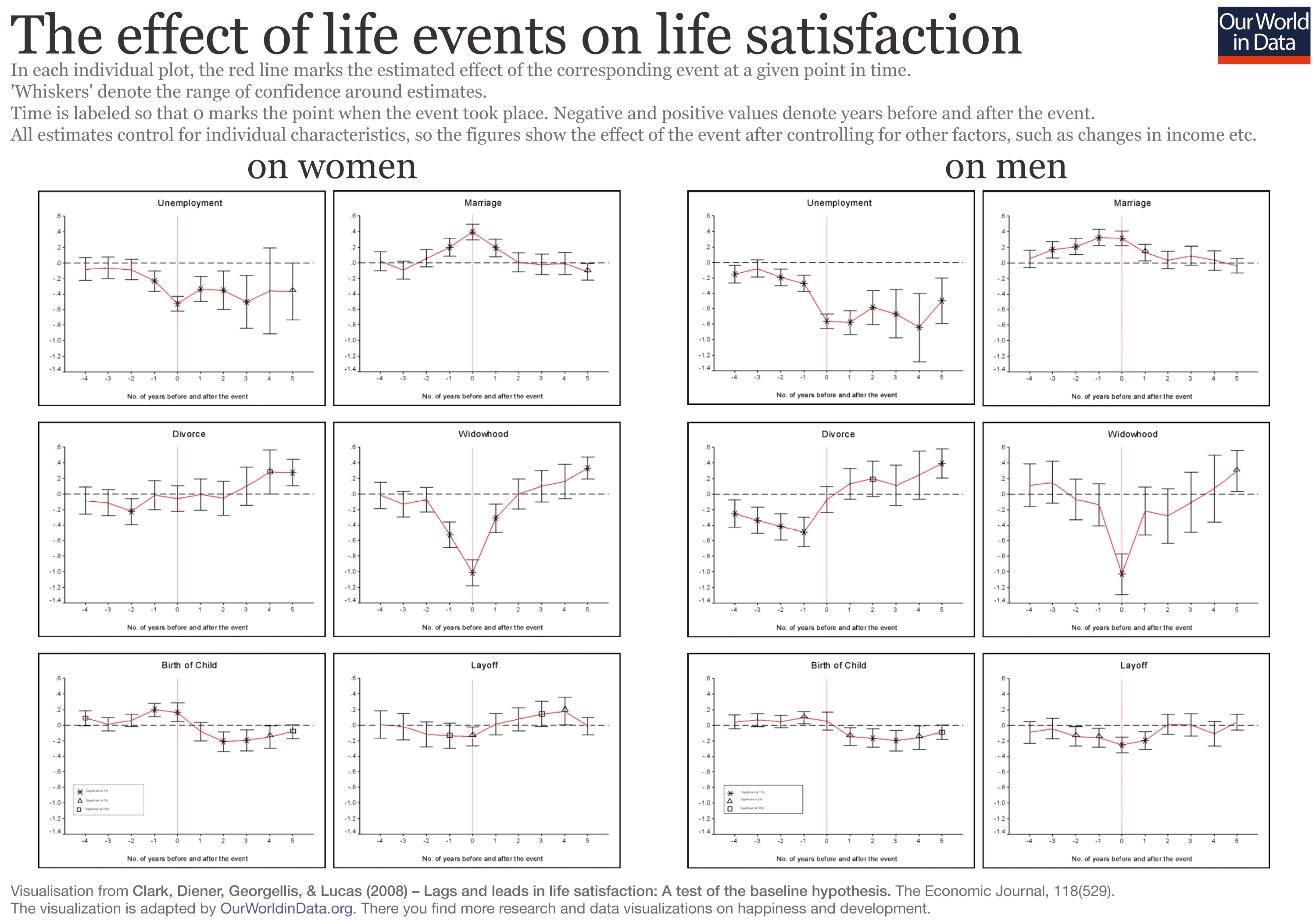
Given India's ~1.4 billion population, such a large drop is alarming: roughly ~5 billion LS-years lost since 2011, very roughly ballparking. For context, and keeping in mind that LS-years and DALYs aren't the same thing, the entire world's DALY burden is ~2.5 billion DALYs p.a.
But – again caveating with my lack of familiarity with the literature and extremely cursory look into this – I haven't seen any writeup look into this, which makes me wonder if it's not a 'real issue'? For instance, the 2021 WHR just says
Since 2006-08, world well-being has been static, but life expectancy increased by nearly four years up to 2017-19 (we shall come to 2020 later). The rate of progress differed a lot across regions. The biggest improvements in life expectancy were in the former Soviet Union, in Asia, and (the greatest) in Sub-Saharan Africa. And these were the regions that had the biggest increases in WELLBYs. In Asia, the exception is South Asia, where India has experienced a remarkable fall in Well-being which more than outweighs its improved life expectancy.
That's it: no elaboration, no footnotes, nothing.
So what am I missing? What's going on here?
A quick search turned up this WEF article (based on Ipsos data and research, not the WHR's Gallup World Poll, so take it with a grain of salt) pointing to
- increased internet access -> pressure to portray airbrushed lives on social media & a feeling that 'their lives have become meaningless'
- covid-19 mitigation-induced isolation curtailing activities that improve wellbeing (employment, socializing, going to school, exercising and accessing health services)
- urban migration to seek work -> traffic congestion, noise and pollution, demanding bosses -> less sleep and exercise -> higher anxiety and worsening health
But I'm not sure these factors are differential (i.e. that they, for instance, happen much more in India than elsewhere s.t. it explains the wellbeing vs development trajectory difference over 2011-24)?
Michael Dickens' 2016 post Evaluation Frameworks (or: When Importance / Neglectedness / Tractability Doesn't Apply) makes the following point I think is useful to keep in mind as a corrective:
INT has its uses, but I believe many people over-apply it.
Generally speaking (with some exceptions), people don’t choose between causes, they choose between interventions. That is, they don’t prioritize broad focus areas like global poverty or immigration reform. Instead, they choose to support specific interventions such as distributing deworming treatments or lobbying to pass an immigration bill. The INT framework doesn’t apply to interventions as well as it does to causes. In short, cause areas correspond to problems, and interventions correspond to solutions; INT assesses problems, not solutions.
(aside: Michael Plant makes the same point in chapters 5 & 6 of his PhD thesis as per Edo Arad's post, using it as a starting point to develop a systematic cause prio approach he called 'cause mapping')
In most cases, we can try to directly assess the true marginal impact of investing in an intervention. These assessments will never be perfectly accurate, but they generally seem to tell us more than INT does. ...
How can we estimate an intervention’s impact more directly? To develop a better framework, let’s start with the final result we want and work backward to see how to get it.
Dickens' post has more; the framework they end up with is this:

which (somewhat less practically, they note) could be fine-grained further:
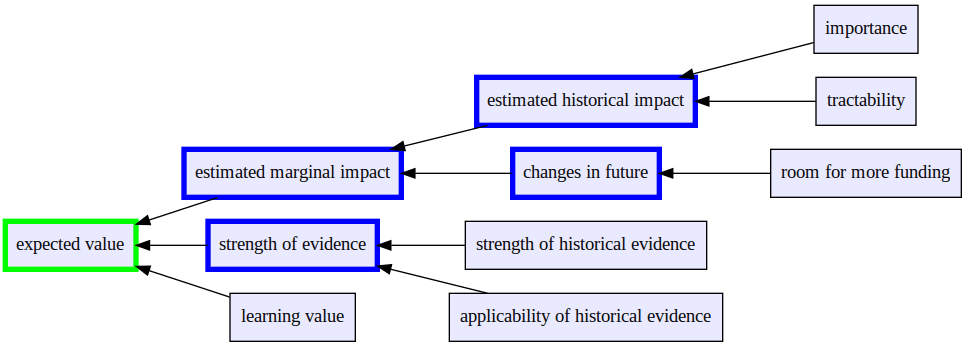
I also appreciated that Dickens actually used this framework to guide their giving decision (more details in their post).

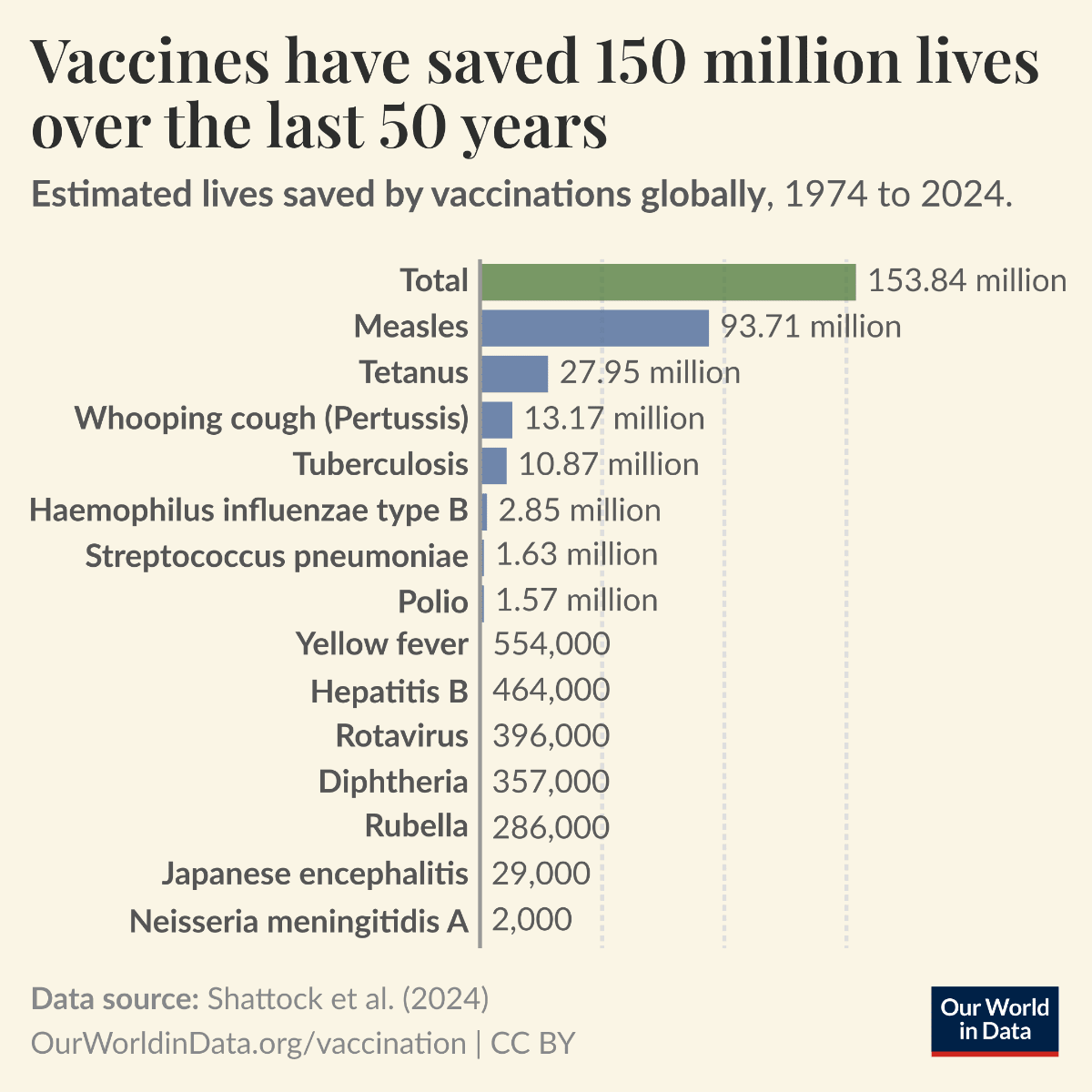
The following is a collection of long quotes from Ozy Brennan's post On John Woolman (which I stumbled upon via Aaron Gertler) that spoke to me. Woolman was clearly what David Chapman would call mission-oriented with respect to meaning of and purpose in life; Chapman argues instead for what he calls "enjoyable usefulness", which is I think healthier in ~every way ... it just doesn't resonate. All bolded text is my own emphasis, not Ozy's.
The modern version of this is probably what Thomas Kwa wrote about here:
An aside (doubling as warning) on mission orientation, quoting Tanner Greer's Questing for Transcendence: